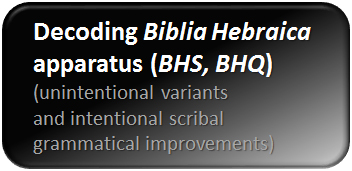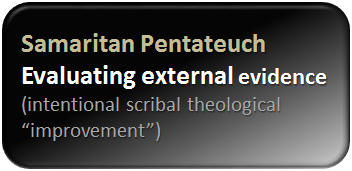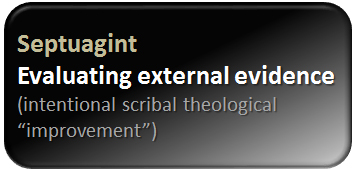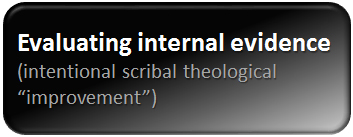 |  |  |  |  |

|
Introduction to Textual Criticism Gary E. Schnittjer Theoretical Goals Deciding the goal of textual criticism is both essential and
difficult because of the nature of the case. It is easy enough to speak of
reliable text upon which to ground exegesis (Würthwein/Fischer), but in the absence of original autographs and
in the presence of available evidence there remains significant philosophical judgments.
Deciding the goal of textual criticism should be taken up in the classroom,
with vigorous discussion of attendant issues and implications. Here are
competing potential goals (Waltke 1989):
→ original text (author) (older
traditional approach) → final text (redactor)
(eclectic text) (BHK apparatus, BHS apparatus, HBCE text,
modern English committee translations, e.g., NRSV, ESV, NIV) → canonical text
(proto-Masoretic c. 1st cent CE) (Childs 1979, 96-99) → earliest attested (excluded
conjectures of non-extant Ur-text) (UBS Text Project, BHQ apparatus, HUB
apparatus) → pluriformity (proto-MT,
Qumran, LXX, Samaritan Pentateuch) (Tov 2008; Biblia Qumranica
[multi-column, DSS, MT, LXX]) Overview Textual Criticism of Hebrew Bible Introducing Biblia Hebraica apparatus: Evaluating External Evidence Begin with apparatus of
critical Hebrew Bible
Analyze important witnesses to scribal variants for oneself.
Evaluating Internal Evidence Investigating internal evidence means thinking with ancient
scribes. Begin by reverse engineering variants based on close attention to scriptural details themselves. Detailed
consideration of scriptural context naturally improves exegetical
outcomes.
→
Evaluate internal evidence (intentional scribal theological
improvement) • Contextual, grammatical, linguistic • Variant by accident or by intention • What factors could explain accidental scribal variation? • What motives could explain “scribal improvements”—grammatical, harmonistic, theological? • Help from commentaries Provisional Decision There are no rules for making responsible text critical
decisions. A couple of general guidelines are often useful.
→
Shorter reading is often preferred → More difficult text is often preferred → “Which is more likely to have given rise to the other?” (McCarter 1986, 72) In addition to sources cited above, I am esp. indebted to Tov 2012, Würthwein/Fischer 2014. Basic provisional timeline of scriptural versions in the second temple context. For further reading Armerding, Carl. The Old Testament and Criticism
(Eerdmans, 1983). Barthélemy,
Dominique. Studies in the Text of the Old
Testament: An Introduction to the Hebrew Old Testament Text Project
(Textual Criticism and the Translator 3; trans. Stephen Pisano et al;
Eisenbrauns, 2012). Biblia Hebraica, ed. Rudolf Kittel, 7th
ed. (Stuttgart: Württ. Bibelanstalt, 1937, 1951). Biblia Hebraica Quinta: Genesis, ed.
Abraham Tal (Deutsche Bibelgesellschaft,
2015); Biblia Hebraica Quinta: Deuteronomy,
ed. Carmel McCarthy (Deutsche Bibelgesellschaft, 2007); Biblia Hebraica Quinta: Judges, ed. Natalio Fernández Marcos (Deutsche Bibelgesellschaft, 2012); Biblia Hebraica Quinta: Minor Prophets, ed. Anthony Gelston (Deutsche
Bibelgesellschaft, 2010); Biblia Hebraica
Quinta: Proverbs (Deutsche Bibelgesellschaft, 2008); Biblia Hebraica Quinta: General Introduction and Megilloth, ed. J.
de Waard, et al (Deutsche Bibelgesellschaft, 2004); Biblia Hebraica Quinta: Ezra and Nehemiah, ed. David Marcus
(Deutsche Bibelgesellschaft, 2006). Biblia Hebraica Stuttgartensia, 5th ed.
(Deutsche Bibelgesellschaft, 1997). Brotzman, Ellis
R. Old Testament Textual Criticism: A
Practical Introduction, 2d ed. (Baker, 2016). Childs, Brevard
S. Introduction to the Old Testament as
Scripture (Philadelphia: Fortress Press, 1979), 96-99. The Hebrew
Bible: A Critical Edition. Michael V. Fox, ed. Proverbs: An Eclectic
Edition with Introduction and Textual Commentary (Atlanta: SBL Press, 2015)
(formerly known as Oxford Hebrew Bible). The Hebrew
University Bible, The Book of Isaiah, ed. M. H. Goshen-Gottstein
(Jerusalem: Magnes, 1995); The Hebrew University Bible, The Book of Jeremiah,
eds. C. Rabin, S. Talmon, E. Tov (Jerusalem: Magnes, 1995). Marcus, David and
James A. Sanders, “What’s Critical about a Critical Edition of the Bible?” Biblical
Archaeology Review 39.6 (Nov/Dec 2013): 60-65. Martin, Gary D. Multiple
Originals: New Approaches to Hebrew Bible Text Criticism. Atlanta: Society
of Biblical Literature, 2010. McCarter, P.
Kyle. Textual Criticism: Recovering the
Text of the Hebrew Bible (Fortress, 1986). Preliminary
and Interim Report on the Hebrew Old Testament Text Project, eds.
Dominique Barthélemy, et al, 5 vols. (New York: United Bible Societies,
1977-1980). Vol. 1, Pentateuch (1979); vol. 2, Historical Books (1979); vol. 3,
Poetical Books (1977), vol. 4, Prophetical Books I, Isaiah, Jeremiah,
Lamentations (1979), vol. 5, Prophetical Books II, Ezekiel, Daniel, Twelve Minor
Prophets (1980). Tov, Emanuel.
“Hebrew Scripture Editions: Philosophy and Praxis,” in Hebrew Bible, Greek
Bible, and Qumran (Tübingen: Mohr Siebeck, 2008), __________. Textual Criticism of the Hebrew Bible,
3d ed. (Fortress, 1992, 2001, 2012). Waltke, Bruce K.
“Aims of OT Textual Criticism,” Westminster Theological Journal 51.1
(1989): 93-108. Wegner, Paul D. A Student’s Guide to Textual Criticism of
the Bible: Its History, Methods, and Results (IVP Academic, 2006). Würthwein, Ernst.
The Text of the Old Testament: An
Introduction to the Biblia Hebraica. 3d
ed. Rev. by Alexanderr Achilles Fischer. Trans. Erroll F. Rhodes
(Eerdmans, 2014). Copyright © 2016
Gary E. Schnittjer |       |

